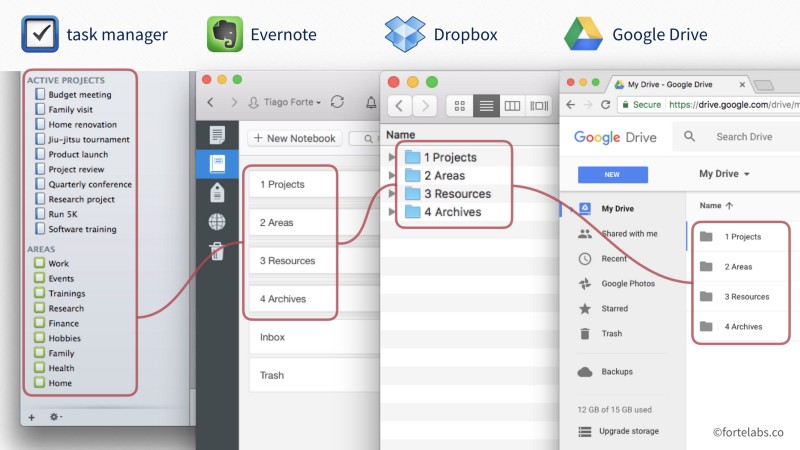Thanks for the helpful demo, Maxime!
How is this method working for you? I’ve read some of Tiago Forte’s stuff with interest, but now that I see it in action, am increasingly skeptical of the four-folders-on-all-devices part of his approach.
I understand the distinction between Projects and Areas of Responsibility. When I had top level folders in my task manager for Grantwriting or Home Improvements it was hard to get a feel for my workload, as those folders got cluttered with a mix of tasks, potential projects that I hadn’t committed to, and reference material. I’ve had much better results now that my list of projects are concrete objectives that could realistically be finished in the next year: “Apply for Grant A,” “Apply for Grant B,” and “Replace window well.”
I do not see the distinction between Areas of Responsibility and Resources. Why does Health have a standard to be maintained but not Cooking? In what way is How eating slow can transform your health and make you more productive more actionable an article than Easy Mini Quiche Recipe?
Do you get something out of the process of moving things between folders, as described in the 3 example workflows? Moving reference material between Resource and Project folders on a task manager, notetaking app like Obsidian, Google Drive, and hard drive or cloud service seems like a lot of work, with the potential to break links to source data and photos in some of the software I use, but I’d consider it if it helped me review and reflect on my ideas and documents.
I think there’s value in defining concrete Projects and envisioning their outcomes, and reflecting on the habits and workflows needed to support your Areas of Responsibility. With each new piece of information you collect, there’s value in thinking about how you might use it for a current or future project. But my inclination would be to link relevant ideas or readings to a project note, rather than move those notes into a project folder. With in line wiki-links, you could clarify exactly how you used the information in the note “Python Mock Patching” for a project, and it gives you the option to associate it with more than one active project, which you can’t do with folders.
I haven’t found much serious discussion of PARA (except for this this thread courtesy of @ryanjamurphy ) and am inclined to dismiss is as equal parts insight and snake oil.

 I probably will redo it with a current theme soon
I probably will redo it with a current theme soon Health” or instead of “Finance”, “
Health” or instead of “Finance”, “ Finance”. At first I thought this was silly but eventually I realized I liked it much more with the emoji’s because it made it much faster to find the category I’m looking for (I can recognize either the word or the picture).
Finance”. At first I thought this was silly but eventually I realized I liked it much more with the emoji’s because it made it much faster to find the category I’m looking for (I can recognize either the word or the picture).